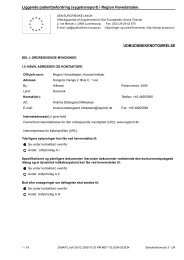Territorial Review Copenhagen - Region Hovedstaden
Territorial Review Copenhagen - Region Hovedstaden
Territorial Review Copenhagen - Region Hovedstaden
You also want an ePaper? Increase the reach of your titles
YUMPU automatically turns print PDFs into web optimized ePapers that Google loves.
184<br />
Denmark's National Board of Health could better promote bicycling use in<br />
cities such as <strong>Copenhagen</strong> through educating the public on the health<br />
benefits of bicycling. Public health professionals could also be better<br />
engaged in the urban planning arena though participating in zoning<br />
decisions, serving on urban planning boards, and incorporating health into<br />
urban planning decision-making. Given the Capital <strong>Region</strong>'s mandate for<br />
hospitals, regional authorities could potentially play a stronger role in<br />
strengthening the interface between bicycle planning and public health.<br />
Enhancing landscape ecology<br />
The demarcation of entire green areas, such as that enshrined in<br />
<strong>Copenhagen</strong>‘s Finger Plan, could be coupled with improved landscape<br />
ecology throughout the urban fabric. Principles of landscape ecology might<br />
be better integrated into the siting and design of individual developments to<br />
minimise the presence of large areas of paving that are void of trees and<br />
vegetation. The tangible forms that these strategies may take are varied.<br />
Many cities, such as Berlin and Freiburg, have funded extensive treeplanting<br />
programs since the 1970s. New York City has followed this<br />
example through the MillionTreesNYC public-private partnership, which<br />
enlists citizens to identify areas for tree-planting and volunteer towards the<br />
planting of one million trees. This growing urban forest has reduced energy<br />
costs, increased storm-water capture, and lessened air pollution<br />
(MillionTreesNYC, 2008). Green roofs or eco-roofs also hold considerable<br />
potential and can be constructed using different designs, such as ―roof<br />
garden intensive‖ (deep soil with irrigation) or ―green roof extensive‖ (thin<br />
soil without irrigation). Green roofs are used more extensively in cities in<br />
Germany, the Netherlands, and Austria, than in <strong>Copenhagen</strong>. 44 Linz, for<br />
example, frequently requires buildings to compensate for the loss of<br />
greenspace through the promotion or requirement of buildings to install<br />
green roofs. Since the late 1980s, the City has often paid up to 35% of the<br />
cost to install green roofs on private residences and commercial buildings.<br />
While in 2009 it will be possible to apply for support for green roof projects<br />
through the Eco City Foundation/Den Byøkologiske Fond, the city does not<br />
have the possibility of providing tax incentives, which would be a strong<br />
incentive. Other urban greening enhancements that <strong>Copenhagen</strong> may more<br />
aggressively pursue include shrubbery, green courtyards, greenwalls, urban<br />
gardens and the construction of green buildings (Beatley, 2000). The City of<br />
<strong>Copenhagen</strong> could identify the most ―green-less‖ sites through using the<br />
Danish Building Research Institute‘s ―biofactor‖ rating system for urban<br />
greenery.<br />
The central square of <strong>Copenhagen</strong> (Rådhuspladsen) needs to better<br />
reflect the region‘s commitment to environmental health. Currently the

















